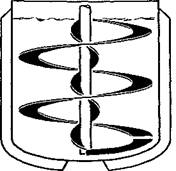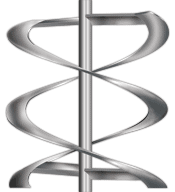| |
High Viscosity Blending
Blending is the operation of combining components of different viscosities and/or densities to produce a material with uniform properties throughout, such that it will not separate with time.
We subdivide blending into two broad classifications;
Low Viscosity - < 50,000 cp
High Viscosity - > 50,000 cp
Blending is divided this way because different impellers are used in high viscosities vs. low viscosities. To be used only as a guideline in determining what types of impellers should be considered.
Blending of high-viscosity materials, which are almost always pseudo-plastic, involves a different concept. The degree of pseudo-plasticity is determined by the exponent n in the equation
shear stress = K(shear rate)^n with value 1 for Newtonian fluids and a value less than 1 representing the degree of decrease of viscosity with an increase in shear rate.
For very viscous materials (on the order of 50 mcP and higher), the helical impeller is often used. Many times this is a double helix, in which pumping on the outside is done by the outer flight, while pumping on the inside is done by the inner flight. Reverse rotation, of course, reverses the direction of the flow in the tank. These impellers typically run at about 5-15 rpm
and have the unique characteristics that the circulating time and blend time are not a function of the viscosity of the fluid. At a given velocity, there is a certain turnover time for a given ZIT ratio, and changing viscosity does not affect that parameter, nor does the degree of pseudo-plasticity affect it. However, the power is directly proportional to the viscosity at the shear rate of the impeller, and so doubling or tripling the viscosity at the impeller shear rate will cause an increase of power of two or three times, even though circulation time will remain the same. Helical impellers are very effective for macroscale blending, but do not typically have the microscale shear rate required for some types of uniformity requirements or process restraints.
 Double Helix Impeller Double Helix Impeller 
Open impellers, such as the axial flow turbine or the radial flow turbine, may also be used in high-viscosity pseudo-plastic fluids. These require a level of power four to five times higher than the helical impeller, but only cost about one-third as much. Another economic comparison is possible to see which is the most effective for a given operation. This higher power level, however, does provide a different level of microscale blending. Occasionally the flow from a blend system with a helical impeller will be passed through a mechanical type of line blender, which imparts a higher level of microscale mixing.
|